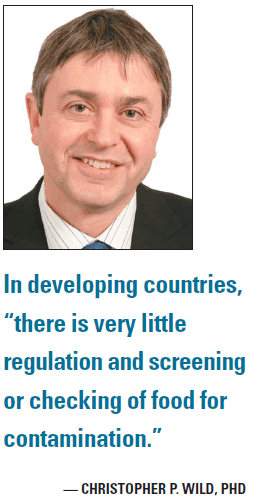Easy methods curtail toxins in food linked to cancer in Africa
WASHINGTON, DC- In much of the developing world, exposure to mycotoxins, which are generated by various types of fungus that grow on food, is ubiquitous. Th e most well-known mycotoxin, aflatoxin, is commonly found on nuts and is a known carcinogen, according to the International Agency for Research on Cancer (IARC).
ABSTRACT: UK-based molecular epidemiologists study how simple food storage methods can lower the presence of mycotoxins linked to liver carcinoma.
WASHINGTON, DC- In much of the developing world, exposure to mycotoxins, which are generated by various types of fungus that grow on food, is ubiquitous. Th e most well-known mycotoxin, aflatoxin, is commonly found on nuts and is a known carcinogen, according to the International Agency for Research on Cancer (IARC).
Exposure to afl atoxin can lead to liver cancer, which causes nearly 10% of all adult male deaths in parts of West Africa, according to Christopher P. Wild, PhD, formerly of the University of Leeds, UK, and now director of IARC. Dr. Wild and his team have shown that simple low-tech measures such as improving the drying and storage of staple foods can reduce the exposure to mycotoxins among subsistence farmers in Africa.

“Mycotoxins contaminate a quarter of the world’s food supply,” explained Dr. Wild at the 2008 Frontiers of Cancer Prevention Research meeting, sponsored by the American Association for Cancer Research. In developing countries, “there is very little regulation and screening or checking of food for contamination.”
Dr. Wild’s group has validated a blood test that detects aflatoxin bound to albumin. The group has used the test in West Africa and found that less than 5% of individuals tested in a series of field trials are negative for the biomarker, he said.
To reduce exposure to mycotoxins, Dr. Wild and colleagues conducted several field trials of simple low-tech interventions in villages in Guinea, West Africa. Joining with local agricultural extension workers, the researchers recruited 600 farmers in 20 villages in Guinea.
Ten villages served as controls, and these received no interventions.
In the other 10 villages, the agricultural extension workers taught farmers how to hand-sort and dry peanuts to prevent fungal outbreaks. The team also provided the farmers with wooden pallets to store nuts and other staple goods off the ground, and they gave the farmers natural fiber bags, which store the foods in lower humidity than do the more common plastic bags. Finally, insecticides were deployed on the floor of the storage facility, as bugs are a main vector for spreading fungus.
Dr. Wild’s team visited the villages three times, at harvest and up to five months post-harvest, to collect blood samples from the villagers. In the control villages, villagers showed a typical pattern of increased levels of aflatoxin with longer storage. But in the villages that received the intervention, levels of the biomarker were relatively steady over time. At the end of the study, the villagers in the intervention villages had 60% less of the biomarker, on average, than villagers in the control villages.
Also, just 2% of the villagers in the control villages had undetectable amounts of the biomarker, whereas the biomarker was undetectable in 20% of the villagers in the intervention villages. “We had quite a significant impact with a very low-tech approach,” Dr. Wild said. He stressed that “none of these (interventions) were new to the communities, but they’d never really been evaluated systematically or applied systematically.”
In South Africa, Dr. Wild’s team tried a similar approach to reduce exposure to another class of mycotoxins called fumonisins. These toxins have been studied less than aflatoxin and are classified as a possible human carcinogen by IARC. Maize, in particular, attracts the type of fungus that produces fumonisins, so Dr. Wild chose villages in South Africa that rely on that staple. In an intervention trial, workers taught women in these villages to discard visibly moldy kernels and then to wash the remaining maize.
Removing about 2.5% of the kernels led to a 60% reduction in the amount of fumonisins present in one batch of maize the investigators tested. The group is still collecting data from the study, but preliminary results on six individuals show that sorting and washing reduced fumonisin exposure, as measured by a urinary biomarker.
Dr. Wild said that he hopes that African governments and nongovernmental organizations will now help implement such simple measures across the continent. “All we’ve done is proof of principle,” he said. “Of course, the next step is rolling this out on a much larger scale.”
While chronic exposure can lead to liver cancer, acute exposure to high doses of aflatoxin can be poisonous. In 2004, Dr. Wild investigated an outbreak of acute aflatoxin poisoning in Kenya that killed several hundred people. In poisoned individuals who recovered, Dr. Wild found the highest concentrations of the biomarker he has ever recorded.